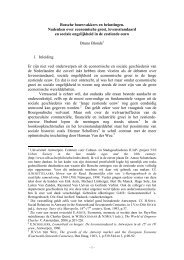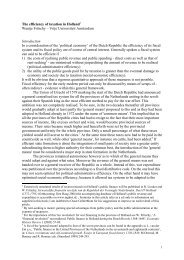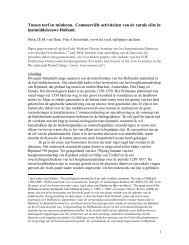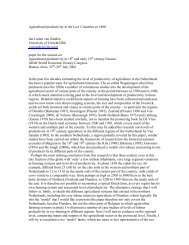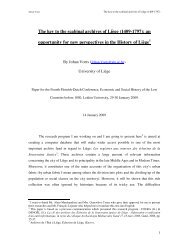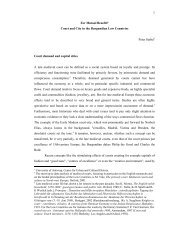Amsterdam as the cradle of modern futures and options trading ...
Amsterdam as the cradle of modern futures and options trading ...
Amsterdam as the cradle of modern futures and options trading ...
You also want an ePaper? Increase the reach of your titles
YUMPU automatically turns print PDFs into web optimized ePapers that Google loves.
<strong>and</strong> West India companies (VOC <strong>and</strong> WIC) first emerged, complete with st<strong>and</strong>ard printed<br />
contracts <strong>and</strong> set rules. In 1688, Joseph Penso de la Vega published a detailed description <strong>of</strong><br />
this phenomenon in his justly famous Confusion de confusiones. 6 With <strong>the</strong> Glorious<br />
Revolution <strong>of</strong> <strong>the</strong> same year, derivative <strong>trading</strong> techniques spread to London through <strong>the</strong><br />
<strong>Amsterdam</strong> bankers <strong>and</strong> traders which followed in William III’s wake.<br />
The subsequent evolution <strong>of</strong> derivatives <strong>trading</strong> is well documented in <strong>the</strong> work <strong>of</strong><br />
Charles Wilson, Peter Dickson, Larry Neal, <strong>and</strong> Ranald Michie. 7 However, we still know very<br />
little about developments prior to 1688. De la Vega gave many details on <strong>the</strong> various <strong>trading</strong><br />
techniques used by contemporaries, but provided no historical survey. During <strong>the</strong> first<br />
decades <strong>of</strong> <strong>the</strong> twentieth century, economic historians have filled at le<strong>as</strong>t part <strong>of</strong> this gap in<br />
<strong>the</strong> historical record. André Sayous, Willem Unger <strong>and</strong> Johannes van Dillen explored <strong>the</strong> use<br />
<strong>of</strong> forwards <strong>and</strong> <strong>options</strong> in <strong>the</strong> grain trade in <strong>the</strong> sixteenth century. 8 Van Dillen also collected<br />
extensive evidence on speculative <strong>trading</strong> in VOC shares around 1610. 9 Likewise, Nicola<strong>as</strong><br />
Posthumus ga<strong>the</strong>red pamphlets, placards, <strong>and</strong> notarial deeds relating to <strong>the</strong> famous tulip<br />
mania <strong>of</strong> <strong>the</strong> late 1630s. 10 These historians shared <strong>the</strong> negative opinion <strong>of</strong> speculation<br />
mentioned above so <strong>the</strong>ir work, however impressive, does not amount to a balanced <strong>and</strong><br />
judicious description <strong>of</strong> derivative <strong>trading</strong>. Moreover, several key questions still remain<br />
unanswered. To what extent did speculative trade in VOC shares modify existing practices <strong>of</strong><br />
forward <strong>trading</strong> in grain, herring, <strong>and</strong> o<strong>the</strong>r bulk commodities? When did <strong>futures</strong> <strong>and</strong> <strong>options</strong><br />
for securities <strong>and</strong> commodities become st<strong>and</strong>ard vehicles at <strong>the</strong> <strong>Amsterdam</strong> exchange? And,<br />
perhaps most importantly, how did derivative <strong>trading</strong> techni ques evolve in <strong>the</strong> face <strong>of</strong> public<br />
hostility which gave rise to repeated <strong>of</strong>ficial bans on short selling? How did traders manage to<br />
create effective rules governing contracts, clearing, <strong>and</strong> <strong>the</strong> transfer <strong>of</strong> counter-party risk?<br />
This paper explores why <strong>and</strong> how a full-fledged market for <strong>futures</strong> <strong>and</strong> <strong>options</strong> first<br />
developed in <strong>Amsterdam</strong> in <strong>the</strong> early seventeenth century. The argument unfolds <strong>as</strong> follows.<br />
First we introduce forwards, <strong>futures</strong>, <strong>and</strong> <strong>options</strong>, <strong>and</strong> explain what is required in <strong>the</strong>ory for<br />
<strong>the</strong>se derivatives to emerge (Section I). In section II we trace <strong>the</strong> origins <strong>of</strong> forwards <strong>and</strong><br />
<strong>options</strong> in commodity trade in <strong>the</strong> Low Countries. Section III reconstructs <strong>the</strong> brisk market for<br />
derivatives that developed after <strong>the</strong> establishment <strong>of</strong> <strong>the</strong> VOC <strong>and</strong> WIC in 1602 <strong>and</strong> 1621.<br />
Section IV analyzes <strong>the</strong> contracts <strong>and</strong> clearing facilities in use in <strong>the</strong> first half <strong>of</strong> <strong>the</strong><br />
seventeenth century. An epilogue in Section V rounds <strong>of</strong>f <strong>the</strong> argument.<br />
1. Forwards, Futures, <strong>and</strong> Options<br />
2



